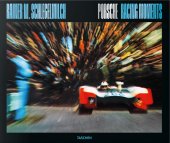COVER STORY
BPR Global GT Series
1994-1996
Rebirth of the cool – 1994
The golden year – 1995
The land of lost content – 1996
Ne Plus Ultra – Hypercars in the BPR Global GT Series
The golden year – 1995
The rules and regulations governing the Global Endurance GT Series changed slightly for the new season. The ACO reduced both the homologation numbers and the minimum weight. Their aim was to increase the chances of a GT taking overall victory in their classic race. A new title sponsor, Kärcher, was a sure sign that BPR was on the rise. Tissot and Shell signed up as well. Official sanction also was evident as, following a meeting with FIA President Max Mosley, BPR were encouraged to apply for FIA approval and a backdated championship status. This was granted a few weeks later, and a GT championship was born!
The momentum that BPR had accumulated in its first season was turbocharged by the impending arrival of McLaren and the F1 GTR. No fewer than six examples would be on the grid once the season got properly underway. Gulf Oil had made an alliance with GTC Competition, meaning that the McLarens of Ray Bellm and Lindsay Owen-Jones would sport the iconic blue-and-orange colours. David Price Racing planned to run Thomas Bscher and John Nielsen in the German banker’s F1 GTR, and it was soon announced that the team would also take on responsibility for Moody Fayed’s car, complete with Harrods sponsorship, courtesy of his uncle. Jacardi Racing would be on the grid after the first few rounds with Olivier Grouillard and Fabien Giroix behind the wheel, and the final example of Woking’s finest was to be from Jean-Luc Maury-Laribière; he would share the car with Laurent Lecuyer, and it would be run by BBA Compétition.
From Maranello a pair of revised Ferrari F40 GT Evoluzione racers had been entered by Ferrari Club Italia. Michelotto had been hard at work during the winter; the aerodynamics had been optimised, the chassis stiffened and a sequential gearbox had been designed and fitted. Olofsson and della Noce would continue their partnership in the Ferrari; the other car would be driven by Gary Ayles, Massimo Monti and Fabio Mancini. Another strong F40 project came from the Pilot Aldix outfit, owned by Stéphane Ratel, with Michel Ferté and Olivier Thévenin on driving duties in their leading car.
Porsche responded to Larbre Compétition’s appeal for an increase in the pace of development of the 911 GT2 to take full advantage of the top class’s regulations. More power would be available soon, up to 550 bhp, which would enhance their chances against the McLarens. And there were other promising GT1 projects arriving: De Tomaso Pantera, Jaguar XJ220, Lister Storm, Dodge Viper and Venturi 600 LM, to name but a few.
In GT2 (BPR GT3) Porsche had a new contender, based on their latest 993 model, aiming to put both Callaway and Ferrari back in their place. Lotus revealed a completely revised Esprit GT project in the development stage, with their former F1 star Alex Zanardi leading the team…
by John Brooks
Photographs: John Brooks
Willy Mairesse
The tragic end for a lonely racer
He was one of the best endurance racers of his generation, but his story is one of the saddest from the 1960s era of motorsport: Willy Mairesse. The Belgian had survived a long career featuring ups, downs, and some horrific accidents. Then in 1968, after he had retired from motor racing to focus on his business and his family, Mairesse decided to make a comeback at the Le Mans 24 Hours. Again he crashed badly, and this time, he never fully recovered from his injuries. On 2 September 1969, unable to bear the physical and psychological trauma he had suffered, Willy Mairesse committed suicide. 2019 marked the 50th anniversary of his death.
Nürburgring, late May 1964. Jacques Swaters, the team boss of Ecurie Garage Francorchamps (EGF), entered two cars into the 1,000-kilometre race: a 250 GTO/64 (#5575) and a brand-new 250 LM (#5843), which had arrived just weeks earlier. The Belgian squad planned to run four drivers: Lucien Bianchi, Jean Blaton (who raced under the pseudonym ‘Beurlys’), Pierre Dumay and Gérard Langlois. At Swater’s invitation another well-known racer was added to the line-up: Willy Mairesse.
Mairesse, still recovering from his big crash at the ’Ring 10 months earlier, returned to the Eifel for the first time. Thanks to a successful operation and an intense rehabilitation programme, he’d all but regained full strength in his right arm. But the long road to recovery had taken its toll on his morale. The invitation from an old friend to come to the Nürburgring was timely. Willy desperately needed it, his psyche at its lowest. The pure joy of being back at a race track, back with his friends, was the right medicine.
In practice the drivers struggled with the mid-engine 250 LM, Swaters having to endure plenty of complaints: ‘This is not a Ferrari. The car is impossible to drive.’ Suddenly, Mairesse waltzed out of the garage, wearing his helmet, and jumped into the car. ‘I’ll do a few laps to see what is possible,’ he said. Swaters gave his man the green light, and watched in amazement as he left the pits at walking pace. After the out lap Swaters switched on his stopwatch, and was even more amazed at what he saw when Mairesse finished his first flyer. He’d just set the fastest lap of any of the EGF drivers. Back in the pits Willy swiftly suggested some brake and tyre changes. The feeling within the team was that Willy was back. And Willy himself felt it, too. Maybe the free fall was over. Maybe it was time to get back on top…
by Etienne Bourguignon
Photographs: Sammlung Peter Hoffmann, André van Bever, Bernard Cahier, Sammlung Nils Ruwisch, Sammlung Etienne Bourguignon, The Revs/Eric Della Faille, Klemantaski, Motorsport Images, Sigurd Reilbach
The Eckhard Schimpf column
Like the old days at Spa or Monte Carlo –
Bugatti Type 59 in Pebble Beach
If there’s a car heaven, I know where to find it. It is located two hours south of San Francisco, on the Monterey Peninsula. Each year, fans from all over the world gather there for a grandiose classic week. It’s bursting full of auctions, rallies, races at Laguna Seca and motorsport gatherings in Carmel Valley. And the Concours d’Elegance at the golf course at Pebble Beach is the jewel in the crown. This year, at the end of this gigantic line-up of beautiful, rare and expensive cars, there was a special highlight: four Bugatti Type 59 grand prix racers.
Is that really so special, you ask? Absolutely. In 1933/34 there were only four genuine factory Bugatti 59s. The last time they were parked together was eight decades ago, at places like Spa or Monte Carlo. To see these four original cars (with chassis numbers 1, 2, 3 and 4) alongside each other again was unique. Putting them together took somebody special to talk the owners – like Ralph Lauren – into handing over the cars. That person was Julius Kruta. It’s little wonder that the 47-year-old is regarded as one of the top Bugatti connoisseurs in the world.
A column like this usually features a personal story, something from the writer’s life. In this case, it’s how Julius and I first met here in Monterey in 2000, at a Bugatti event. I can’t remember who it was, but somebody told me: ‘You know, there’s someone here that knows more about racing cars than you do.’ I was curious. That someone was a then-28-year-old Julius Kruta. After one tour of the Laguna Seca paddock, it was clear that he had a phenomenal level of expertise. We’ve been friends ever since, and have met 15 times at Pebble Beach where he’s helped grow my Bugatti knowledge…
by Eckhard Schimpf
Photographs: Rémi Dargegen, Julius Kruta, Dominic Fraser
Jim Clark’s forgotten Lotus
47th AvD-Oldtimer-Grand-Prix
Among the field at the 2019 Oldtimer Grand Prix was a car that lapped the beautiful old Nordschleife back in 1966. Light and slim, the traits of a perfect racing machine. But the Lotus 44 was a failure and fell into the oblivion.
The 1965 season was all about Jim Clark. The shy Scot won the Formula 1 World Championship, the Indy 500, the French and British Formula 2 Championships and a number of other races. The 1966 season, however, was a stark contrast for Clark and Lotus. Brabham got the switch from 1.5-litre to three-litre power just right, whereas Lotus was held back by the BRM H16 engine. It was a similar story in Formula 2, the Brabham BT18s of Jack Brabham and Denny Hulme setting the pace. The new Matra MS5, and the Roy Winkelmann Racing-run BT18s, were competitive to an extent. But with the new 44, Lotus was unable to continue the previous year’s success.
The Lotus 44 was a dedicated Formula 2 car, largely based on its predecessor, the Lotus 35. The most significant changes were a new suspension and a wider track, just like the Formula 3-spec Lotus 41. Built around a lightweight aluminium monocoque, the car was powered by the latest Cosworth SCA injected engine making around 140 horsepower. There were only three 44s built: F2-1, F2-2 and F2-3. They were run by Ron Harris, who had looked after the Lotus F2 and F3 programmes since 1964. Clark and Peter Arundell, who returned after a long break due to injury, were the regular drivers. There were also plans for a third car for young American Peter Revson.
The Lotus 44 was first used at the Grand Prix de Pau in mid-April of 1966. Clark drove the car in first practice, before switching back to the proven 35 for the rest of the weekend. A race debut came a week later, as Harris’s team split up for the weekend. As Arundell finished second at the ‘Eifelrennen’ in Germany, Clark raced a 44 and Francisco Godia Sales a 32 at the Gran Premio de Barcelona. Clark retired with engine problems after 14 laps and ‘Paco’ Godia didn’t see the finish, either. From Barcelona it was off to Zolder, where Harris had two 44s for Arundell and John Cardwell, as well as a 32 for Rob Slotemaker. The Brabham-Honda duo won; Arundell was the only Lotus to make the finish in sixth…
by Jacob Queissner
Photographs: Detlef Sauer, McKlein
- Norbert Singer about Fiorano 1992
- Jo Ramirez about GP Spa 1967
- Back on Track Gebhardt 88C2 Audi
- and many more!




